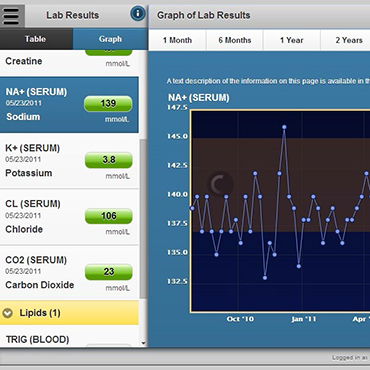VA mobile apps link into the Vista health record

The VA is moving forward with a suite of apps for patients and providers that feature live connections into VA health records.

The VA is moving forward with a suite of apps for patients and providers that allow live connections into VA health records and enable such features as the summary of care seen above.
Veterans and the providers who treat them are increasingly getting access to mobile apps that tie into the enterprise-wide electronic health records system Vista. The Department of Veterans Affairs is in the midst of field testing two patient-facing apps, the Mobile Blue Button and the Summary of Care app, and is set to begin testing on a provider-focused app called simply Patient Viewer.
The Patient Viewer app is envisioned as a big efficiency booster, said Dr. Kathy Frisbee, co-director of the Connected Health program inside the Office of Informatics and Analytics at the Veterans Health Administration. Currently, appointments with multiple providers mean multiple log-ons in examination and hospital rooms, which can add three minutes per provider to the time it takes to see a patient. With a mobile app, doctors, nurses and technicians will have their own devices in hand, all with access to the same record. Patient Viewer also allows providers to write to the Vista record.
The apps are all designed with mobile-optimized HTML 5, and can scale to any device, or be used on a laptop or desktop. But the goal is a handheld experience.
"The hypothesis is that these mobile devices will save approximately five minutes per patient, which will increase the number of patients that we can potentially see," Frisbee said. The VA is planning to start field testing the app this summer to about 100 health care team members. If all goes well, the app will release across VA in the mid- to late fall.
The Mobile Blue Button and Summary of Care apps have been field testing since November 2014 to a group of veterans in VA care who work for the agency. The VA hopes to have those two in the field for late summer or early fall. The Mobile Blue Button app gives patients access to their medical record. The Summary of Care provides a look at more recent info such as lab results, medications, consultations ordered and vitals data.
As the VA gets closer to a wide release of these apps, they have to figure out what is needed to support all the data requests. "Mobility is a new journey for many organizations -- the VA included. So part of this is building, beyond just the application itself, the infrastructure to support a robust mobile program," said Dr. Neil Evans, the other co-director of the Connected Health Program.
This means making sure servers are resourced properly to handle the volume of requests, but also focusing on development processes so successive iterations can be built as feedback is collected on each app from pilot testers. It also means having a data strategy to make sure the apps remain relevant as VA moves ahead with major changes to its health record.
The VA recently announced plans to roll out a new Vista interface called the Enterprise Health Management Platform. EHMP will support app development by members of the open source community who use Vista through a software development kit. The VA is following the same data model as EHMP. This allows patient data gathered by apps to flow into EHMP, Frisbee said.
Struggling with Funding
The VA is facing a $2.5 billion budget shortfall, as Deputy Secretary Sloan Gibson told Congress in a June 25 hearing of the House Veterans Affairs Committee. The VA is scrambling to find funding to meet increased demand for services, and to dig out of crises ranging from the massively over budget construction of a Denver hospital. Bureaucrats and appropriators are going to be looking everywhere for savings. Gibson told Congress that furloughs, hiring freezes and other measures are on the table.
"We are struggling with funding just like everybody else," Frisbee said. "We do believe that these virtual care modalities will improve our ability to see more patients, improve access, and improve the experience of veterans," she said.






